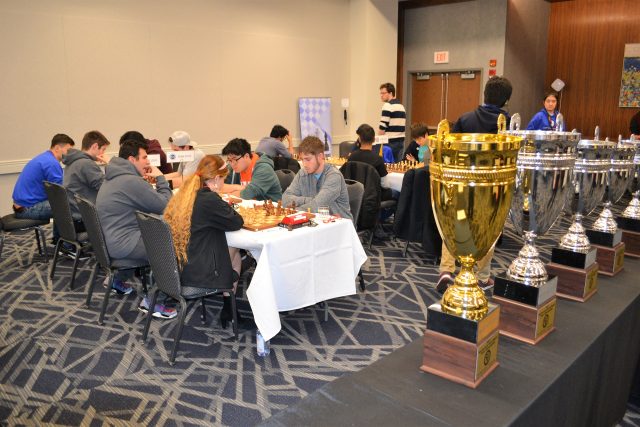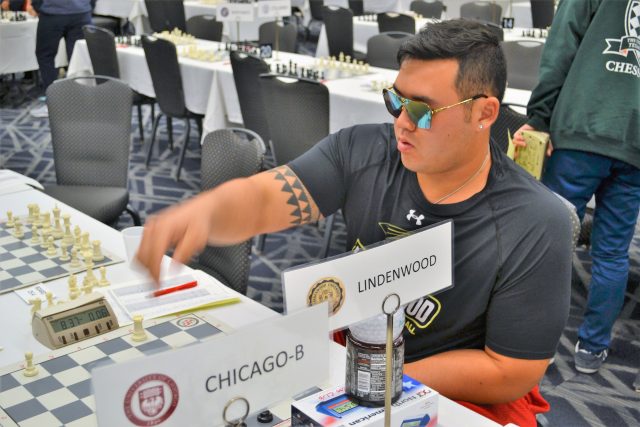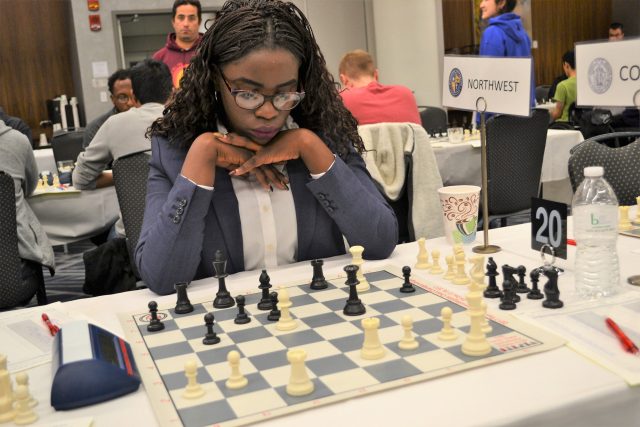Big ratings don’t guarantee smooth sailing. This week the Convention Center in downtown Columbus, Ohio, is an easy place to get a game of chess. But it’s a very tough place to score a win, with 15 GMs and 29 IMs on top boards among the 245 collegiate players prowling for points. Also among them are hungry class players, out for upsets. Eleven of the 58 teams at the annual Pan-American Intercollegiate Team Chess Championship sport an average U.S. Chess rating of over 2400. Defending champ Webster University, coached by GM Susan Polgar, boasts a top team with a 2724 average rating. Second seed St. Louis University (SLU) is close behind at 2702, even though its program is barely two years old. Ratings don’t guarantee results. Even round one yielded a major team upset, as UT-Dallas “D,” a scholarship squad with an average rating well over 2200, gave up a draw to Illinois “C”—a scrappy team made up of four class B players. And an individual upset with a swing of 600 points exploded on Table 6, Board 2, as A-player Andrew Sheehan scored the full point against GM Gil Popilski.
[pgn] [Event "2017 Pan American Intercollegiate Chess "] [Site "Columbus, Ohio"] [Date "2017.12.27"] [White "Popilski, Gil"] [Black "Sheehan, Andrew"] [Result "0-1"] [ECO "B89"] [WhiteElo "2550"] [BlackElo "1967"] [PlyCount "66"] [EventDate "2017.12.27"] [EventRounds "6"] [SourceDate "2017.12.28"] {First Round Upset: Andrew Sheehan, playing Black against UT-Dallas "A" GM Gil Polilski, spotted the champ 600 points. After a back-and-forth tactical melee, Sheehan came away with a GM scalp and his team's only point.} 1. e4 {First Round Upset: Andrew Sheehan, playing Black against UT-Dallas "A" GM Gil Polilski, spotted the champ 600 points. After a back-and-forth tactical melee, Sheehan came away with a GM scalp and his team's only point.} c5 2. Nf3 d6 3. d4 Nf6 4. Nc3 cxd4 5. Nxd4 Nc6 6. Bc4 e6 7. Be3 a6 8. Qe2 Qc7 9. O-O-O Na5 10. Bb3 b5 11. g4 Nxb3+ 12. axb3 b4 13. g5 bxc3 14. gxf6 gxf6 15. Qf3 Be7 16. Rhg1 cxb2+ 17. Kxb2 Bb7 18. Rg7 Rf8 19. Nxe6 $5 {When you're rated 600 points ahead of your opponent, you have to look for winning possibilities!} fxe6 20. Qh5+ Kd8 {21. Qxh7} 21. Bc5 $2 {21. ... Bxe4 +-} Bd5 {=} 22. Qxh7 $17 {22. Ba3} Re8 23. Be3 Bb7 24. c4 a5 25. Rdg1 a4 26. Rf7 axb3 27. Rg8 Rxg8 28. Qxg8+ Kd7 29. Rxe7+ Kxe7 30. Qg7+ Kd8 31. Qf8+ Kd7 32. Qf7+ Kc6 33. Qxe6 Qa5 0-1 [/pgn]
In round three, Peter Gabrielides of Oberlin College chalked up a 933-point upset as Black against a 1749 player. The PanAms offers a plaque for biggest individual upset and Peter leads the upset pack at the halfway point. [pgn] [Event "?"] [Site "?"] [Date "2017.12.28"] [White "Gunsolus, Beren"] [Black "Gabrielides, Peter"] [Result "0-1"] [ECO "B12"] [PlyCount "58"] [EventDate "2017.??.??"] 1. e4 c6 2. d4 d5 3. f3 Nd7 4. Bd3 e5 5. Be3 Bd6 6. Ne2 Ne7 7. Nd2 O-O 8. c4 dxc4 9. Bxc4 b5 10. Bb3 Bb7 11. O-O a6 12. f4 exd4 13. Nxd4 c5 14. N4f3 c4 15. Bc2 f5 16. e5 $2 Nd5 $1 17. Bf2 Bc5 18. Nd4 Nxf4 19. N2f3 Nxe5 $1 20. Nxe5 Bxd4 21. Bxd4 Qxd4+ 22. Qxd4 Ne2+ 23. Kh1 Nxd4 24. Bd1 Rad8 25. a4 Rfe8 26. Nf3 Bxf3 27. Bxf3 Nb3 28. Ra2 Nd2 29. Rf2 Re1+ 0-1 [/pgn]Webster's "C" and "D" teams, also scored board one upsets. https://twitter.com/SusanPolgar/status/946497584151056384 Teams play four-on-four in a six-round Swiss tournament ending on Saturday, giving the student-players just enough time to travel home for New Year’s celebrations. The players on the very top teams are chiefly European GMs on full scholarships. But all players must meet strictly enforced rules certifying that they are degree-seeking students in good standing at their respective colleges. Titled players may have to meet even tougher standards. Other top contenders are University of Texas-Rio Grande Valley (UT-RGV) (formerly UT-Brownsville) coached by GM Bartek Macieja, Texas Tech University, coached by GM and former U.S. Champion Alex Onischuk, and UT-Dallas—a 10-time PanAms champ. All three teams average around 2600. All top five seeds except SLU entered multiple teams, giving themselves extra bullets in the shoot-out for a spot in the top four. At the finale of the PanAms, the top four U.S. universities qualify to send one team to the Final Four of College Chess, this year to be held over Easter weekend at the Marshall Club in New York City. Qualifying universities can send one team, made up of any students they choose. This year at the PanAms, there are very strong teams without the backing of a chess scholarship program. The University of Michigan comes in with a 2462 average rating, led on Board 1 by IM Atulya Shetty. Harvard is another 2400-plus crew, with GM Darwin Yang and IM Richard Wang on its first two boards. UC-Berkeley is near 2400, with IMs Yian Liou and Kessav Viswanadha on its top spots. The University of Toronto and Chicago U. are other colleges with impressive “pick-up” teams.
 The three-person team from Alaska Pacific College seems ready for the frigid weather outside the Hyatt Regency Convention Center at the PanAms in Columbus, Ohio. Left to right: Jonathon Singler, Carson Kent, Emily Jean Smith.
The three-person team from Alaska Pacific College seems ready for the frigid weather outside the Hyatt Regency Convention Center at the PanAms in Columbus, Ohio. Left to right: Jonathon Singler, Carson Kent, Emily Jean Smith.But teams at the PanAms range from Webster A’s Olympiad-worthy rating to Alaska’s three-digit average. There are plenty of division and special prizes any team can shoot for. Bringing home any of the many trophies and plaques can be a boost to a college chess program. Five international teams are competing this year, certainly a recent record—three from Canada and two from Mexico.
One of the U.S. players farthest from home is Lucas Beddow, who came to Lindenwood University, in the western St. Louis suburb of Saint Charles, Missouri. Lindenwood offers partial scholarships for chess. Beddow, however, came on a full scholarship for football. “But it was very important that Lindenwood had a chess program," the veteran of two scholastic SuperNationals said. Another player far from home is Phiona Mutesi, whose early chess life was chronicled in the 2012 book and 2016 film “Queen of Katwe.” She has left Uganda to this fall attend Northwest University in Kirkland, Washington. “Friends in Uganda recommended Northwest,” she said.
This year’s event is one of the most spaciously and graciously hosted of all time, presented by Ohio State University and organized by Kelly Bloomfield, a veteran member of the US Chess College Chess Committee. Former U.S. Chess Executive Director and CFO Grant Perks heads the directing team, aided by Kathy Lin, Al Valentine, and Ben Tancinco. The national championship is held under the auspices of U.S. Chess, with support from the U.S. Chess Trust and Akuna Capital. The Pan-Am Intercollegiate Team Championship is open to any team of four players and up to two alternates from the same post-secondary school in North America, Central America, South America, or the Caribbean. Average ratings are calculated on the top four players. The tournament has been held every hear since 1946. Next year’s PanAms will be held December 27-30 in San Francisco. Follow the Pan-American Championships on the official site, which features live games of the top boards. Find pairings and standings here.
Categories
Archives
- January 2026 (3)
- December 2025 (27)
- November 2025 (29)
- October 2025 (39)
- September 2025 (27)
- August 2025 (29)
- July 2025 (43)
- June 2025 (25)
- May 2025 (24)
- April 2025 (29)
- March 2025 (29)
- February 2025 (20)
- January 2025 (24)
- December 2024 (34)
- November 2024 (18)
- October 2024 (35)
- September 2024 (23)
- August 2024 (27)
- July 2024 (44)
- June 2024 (27)
- May 2024 (31)
- April 2024 (51)
- March 2024 (34)
- February 2024 (25)
- January 2024 (26)
- December 2023 (29)
- November 2023 (26)
- October 2023 (37)
- September 2023 (27)
- August 2023 (37)
- July 2023 (47)
- June 2023 (33)
- May 2023 (37)
- April 2023 (45)
- March 2023 (37)
- February 2023 (28)
- January 2023 (31)
- December 2022 (23)
- November 2022 (32)
- October 2022 (31)
- September 2022 (19)
- August 2022 (39)
- July 2022 (32)
- June 2022 (35)
- May 2022 (21)
- April 2022 (31)
- March 2022 (33)
- February 2022 (21)
- January 2022 (27)
- December 2021 (36)
- November 2021 (34)
- October 2021 (25)
- September 2021 (25)
- August 2021 (41)
- July 2021 (36)
- June 2021 (29)
- May 2021 (29)
- April 2021 (31)
- March 2021 (33)
- February 2021 (28)
- January 2021 (29)
- December 2020 (38)
- November 2020 (40)
- October 2020 (41)
- September 2020 (35)
- August 2020 (38)
- July 2020 (36)
- June 2020 (46)
- May 2020 (42)
- April 2020 (37)
- March 2020 (60)
- February 2020 (38)
- January 2020 (45)
- December 2019 (34)
- November 2019 (35)
- October 2019 (42)
- September 2019 (45)
- August 2019 (56)
- July 2019 (44)
- June 2019 (35)
- May 2019 (40)
- April 2019 (48)
- March 2019 (61)
- February 2019 (39)
- January 2019 (30)
- December 2018 (29)
- November 2018 (51)
- October 2018 (45)
- September 2018 (29)
- August 2018 (49)
- July 2018 (35)
- June 2018 (31)
- May 2018 (39)
- April 2018 (31)
- March 2018 (26)
- February 2018 (33)
- January 2018 (30)
- December 2017 (26)
- November 2017 (24)
- October 2017 (30)
- September 2017 (30)
- August 2017 (31)
- July 2017 (28)
- June 2017 (32)
- May 2017 (26)
- April 2017 (37)
- March 2017 (28)
- February 2017 (30)
- January 2017 (27)
- December 2016 (29)
- November 2016 (24)
- October 2016 (32)
- September 2016 (31)
- August 2016 (27)
- July 2016 (24)
- June 2016 (26)
- May 2016 (19)
- April 2016 (30)
- March 2016 (36)
- February 2016 (28)
- January 2016 (32)
- December 2015 (26)
- November 2015 (23)
- October 2015 (16)
- September 2015 (28)
- August 2015 (28)
- July 2015 (6)
- June 2015 (1)
- May 2015 (2)
- April 2015 (1)
- February 2015 (3)
- January 2015 (1)
- December 2014 (1)
- July 2010 (1)
- October 1991 (1)
- August 1989 (1)
- January 1988 (1)
- December 1983 (1)










